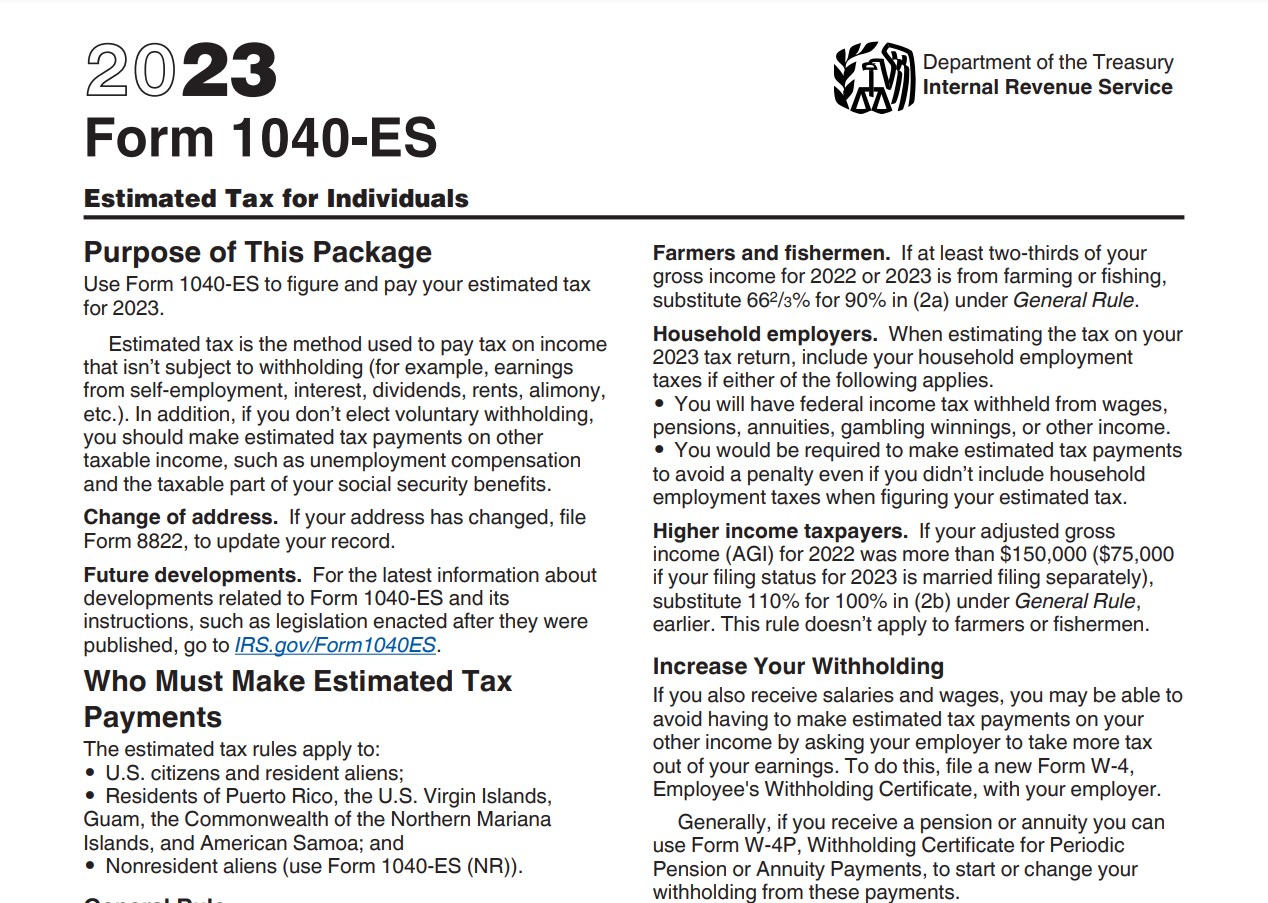Table of Contents
1040-ES Form 2023 – Form 1040-ES, or Estimated Tax for Individuals, is an important IRS form that individuals must file to pay their estimated taxes. The estimated taxes taxpayers owe each year depends on the individual’s income and tax situation. Filing Form 1040-ES accurately and on time helps taxpayers avoid costly penalties and interest from the IRS.
1040-ES Form is a tax form used by individuals in the United States to calculate and pay estimated taxes. Estimated taxes are payments made throughout the year to the Internal Revenue Service (IRS) for income that is not subject to withholding. This includes income from self-employment, investments, and rental properties.
Individuals must pay estimated taxes if they expect to owe at least $1,000 in taxes for the current year after subtracting any credits and withholding. The 1040-ES form provides a worksheet to help individuals calculate their estimated tax liability and determine the amount they need to pay.
To complete the 1040-ES form, individuals need information about their income and deductions and any credits they are eligible to claim. This information can be found on other tax forms, such as the 1099 form for income from self-employment or investments and the W-2 form for wages and salaries.
Once the form is completed, individuals can make estimated tax payments using several methods, including mail, online, or through their bank or other financial institution. Making these payments on time is essential, as failure to pay estimated taxes can result in penalties and interest charges.
In addition to the 1040-ES form, the IRS provides instructions and other resources to help individuals understand and comply with the estimated tax requirements. These resources can be found on the IRS website or by contacting the IRS directly.
Who Needs to Pay the 1040-ES Form?
Individuals who expect to owe at least $1,000 in taxes for the current year must pay estimated taxes using the 1040-ES form. This includes income from self-employment, investments, and rental properties that is not subject to withholding by an employer.
It is important to note that not everyone who is self-employed or has income from investments or rental properties will necessarily be required to pay estimated taxes. The requirement to pay estimated taxes is based on the amount of tax an individual expects to owe after considering any credits or withholding that may apply.
Individuals unsure if they need to pay estimated taxes can use the 1040-ES form to calculate their estimated tax liability and determine if they are required to make payments. They can also contact the IRS directly for assistance.
What Happens If I Don’t Pay 1040-ES Form?
If you are required to pay estimated taxes and do not make your payments on time, you may be subject to penalties and interest charges. The penalties for failure to pay estimated taxes are based on the amount of tax you owe and the time the payment is overdue. Generally, the longer you wait to pay your estimated taxes, the higher the penalty will be.
In addition to penalties, you may also accrue interest on the unpaid portion of your estimated tax liability. The IRS determines the interest rate which is subject to change each quarter. Interest is charged daily until the tax is paid in full.
If you fail to pay your estimated taxes, the IRS may also take collection action against you. This can include seizing assets, garnishing wages, or levying bank accounts. To avoid these consequences, making your estimated tax payments on time is important.
When to File 1040-ES Form?
- April 15, 2023
- June 15, 2023
- September 15, 2023
- January 15, 2024
It is important to note that these dates may be adjusted if they fall on a weekend or a holiday. Additionally, the IRS may change the due dates for estimated tax payments in future years, so it is always best to check the IRS website or instructions for the 1040-ES form to confirm the current due dates.
Individuals required to pay estimated taxes should file the 1040-ES form and make payments by the applicable due date for each payment period. This will help to ensure that they avoid penalties and interest charges.
What is the Purpose of Form 1040-ES?
The purpose of Form 1040-ES is to calculate and pay estimated taxes for the tax year 2023. Estimated taxes are payments made for income not subject to withholding, such as self-employment earnings, interest, dividends, rents, alimony, and other sources of income. Additionally, individuals who do not elect voluntary withholding may need to make estimated tax payments on other taxable income, such as unemployment compensation and the taxable portion of social security benefits. Form 1040-ES provides a worksheet to help individuals calculate their estimated tax liability and determine the amount they need to pay.
1040-ES Form 2023 Download
For more information about the 1040-ES Form, you can read the form itself or download it here.
